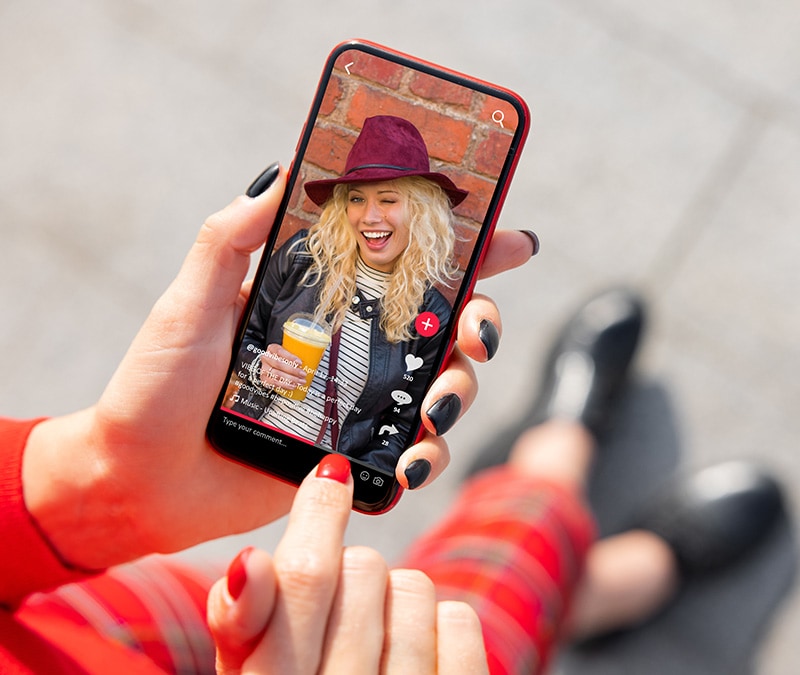A guide for how to spot fake news
Fake news can be hard to spot for adults and children — especially with the rise of AI-generated deepfakes. Here’s a guide to help decipher what’s real and what’s fiction on the internet. Then get Norton 360 Deluxe for cutting-edge Deepfake Detection that can flag manipulated video.

Do you suspect that the COVID-19 pandemic was caused by 5G wireless technology? Or maybe you're hesitant to get a COVID-19 vaccine because you worry that Microsoft's Bill Gates is pushing the shots to secretly implant people with tracking devices.
Or maybe you're ready to donate $100 to save the endangered Pacific Northwest tree octopus, an octopus that, as its name suggests, lives not only in the water but in tree branches, too.
If so, you've fallen victim to fake news. Fake news comprises stories, videos, and images deliberately designed to mislead readers.
Some fake news is dangerous, such as stories centering on Bill Gates and tracking devices that aim to sow doubt about COVID-19 vaccines among the public. Others are clearly satire, such as that fake story about octopuses living in trees. (Don't bother looking up. Your tree is free of eight-legged visitors.)
The challenge? Fake news has long been on the rise, spreading quickly through social media, online forums, and message boards. And while some fake news stories are outlandish and easily spotted, other false stories and deepfake videos are subtle and can be hard to recognize.
Worried about falling victim to fake news? Here’s how it works and some clues you can look for when trying to determine what's real and what's not on the internet.
What is fake news?
The definition of fake news is a simple one: It's any story, image, or video spreading untrue information while disguising itself as credible reporting.
Fake news stories generally use provocative headlines that encourage readers to click on a video or story. For instance, a headline might say "Biden ready to ban Mr. Potato Head." The story might then contain false information designed to trick readers into thinking politicians on the other side of their beliefs are ready to do something terrible or ridiculous.
Fake news gained new attention during the 2016 presidential election, when it flooded social media sites. A Stanford University study found that fake stories favoring Donald Trump were shared a total of 30 million times during the presidential election. Fake stories promoting Hillary Clinton were shared nearly four times less during the election, according to Stanford.
Fake news has continued to grab headlines, largely as it is spread through social media sites such as Facebook, Twitter, Instagram, and Reddit. After the January 6, 2021 riots at the U.S. Capitol, Twitter took the step of banning former President Trump from posting, claiming that the then-President was spreading false and dangerous information through the service.
Fake news, though, isn't new. As the Center for Information Technology & Society at the University of California Santa Barbara says, fake and distorted news has existed since the invention of the printing press. A prominent example? The Center points to the propaganda efforts used by the Nazis to build distrust of Jewish people.
The Center points, too, to the 1800s in the United States, when newspapers tried to denigrate African Americans by publishing fake news about the crimes they were supposedly committing.
And in the 1890s, a rivalry between newspaper publishers Joseph Pulitzer and William Hearst helped coin the term "yellow journalism," an early example of fake news. The publishers specialized in printing rumors and sensationalized stories to boost their readerships.
Fake news continues to play a role today. Look at the distribution of COVID-19 vaccines. Microsoft's Bill Gates has had to go on record to dispute the fake news that he wants to use the vaccines to implant people with tracking devices.
Then there's the 5G myth: Stories persisted almost from the start of the pandemic that the spread of COVID-19 was somehow caused by 5G cellular technology. The Journal of Medical Internet Research published a study in December 2020 showing that of all the myths surrounding coronavirus, the 5G one spread the fastest.
What are the different types of fake news?
Not all fake news is created equal. Some types of fake news aren’t even intended to be harmful or to mislead.
Here’s a look at the different types of fake news you might encounter on social media or while you’re scouring the internet.
Satire or parody
Websites such as The Onion or the Babylon Bee pretend that they are news sites but instead publish parody or satire. Consider a recent headline on the Babylon Bee: "Terrified Biden Wanders Around The White House Wondering Where Obama Went." Or this headline by The Onion: "Zookepers Confirm Pandas Not Mating Because They're Scared Of Messing Up Friendship."
These stories are obviously satire and are not intended to mislead readers. But this doesn't mean that these fake news stories can't trick some. John Fleming, a U.S. Representative from Louisiana, is an example. In 2012, he posted a fake story from The Onion to his Facebook page, angry that Planned Parenthood was opening an $8 billion Abortionplex in Topeka, Kansas. The problem? The story was obviously fake.
False connection
Sometimes a story is mostly true, but a headline or image used with it is misleading. This creates a false impression or what some researchers call a false connection.
For instance, in 2018, newspapers and sites ran several stories focusing on the immigration policies of the Trump administration. One story showed photos of immigrant children detained behind what looks like a metal fence. This led to criticism of the Trump administration for keeping kids in cages.
Those photos are shocking. But they were actually taken by the Associated Press in 2014 during the administration of President Barack Obama. The photos, then, were misleading because most readers would see them and assume they were taken instead during the days of Trump's presidency, not Obama’s.
Propaganda
Sometimes governments, corporations, or other organizations spread biased or misleading information to promote a specific cause or issue. This type of fake news is known as propaganda.
Countries have a history of engaging in propaganda to promote themselves or their military might. For instance, in 2013, Iran published photos showing their new stealth fighter jet flying over a mountain in Northern Iran. It was later discovered that the image was manipulated using photo-editing software.
This type of propaganda isn't new. Alexander the Great, the famed leader of the ancient Greek kingdom of Macedonia, was known to leave behind armor and helmets that were extremely large. That way, when opposing armies saw it, they thought that the Macedonian army was made up of giants.
Clickbait
Clickbait is the art of writing headlines that are intentionally misleading. They promise something scandalous or shocking. But the actual story attached to them is usually bland or at least isn’t directly related to the more salacious headlines. The goal is to get people to click on news sites so that the owners of these sites earn extra views and the dollars that come with them.
An example? You might find this headline on well-known clickbait site Zergnet: "The Truth About Donald Trump's Youngest Son is Out Now." Sounds salacious, right? What could this truth be? Clicking on the headline, though, takes you to a rather innocuous story on the Nicki Swift site with this headline: "Things You Didn't Know About Barron Trump." The story includes such non-scandalous facts such as Barron Trump being the only child of Donald and Melania Trump and that Melania Trump planned to keep her son out of the spotlight during her husband’s presidency. Not exactly the shocking revelations that the other headline teased.
Conspiracy theory
Conspiracy theories have long popped up online. These theories promote a false, often shocking narrative, usually designed to make one political party look bad.
The Pizzagate conspiracy is a good example. This conspiracy theory states that the Washington, D.C.-based pizzeria Comet Ping Pong is a front for a child trafficking ring led by Hillary Clinton and other prominent Democrats. This theory, of course, is completely false. But as ridiculous as it sounds, some still believe this conspiracy theory.
Misinformation
Sometimes fake news is more subtle. It might contain a hint of truth that is largely obscured by false information. An example? The story that former President Donald Trump sent his personal plane to Camp Lejeune, North Carolina, to pick up 200 U.S. Marines who were stranded there after fighting in the 1991 Persian Gulf War.
There is some truth here. A plane from Trump's shuttle fleet did pick up some stranded Marines. But the planes were more than likely extra ones that by that time had been contracted out to the U.S. military to ferry personnel during Operation Desert Storm. So while a Trump plane might have picked up stranded Marines, it's unlikely that Trump himself had anything to do with the decision.
Pseudoscience
Scammers have long promoted fake cures for a wide variety of diseases. They promise that ingesting a certain liquid, swallowing a pill, or eating a certain fruit will cure you of cancer, eliminate your headaches, or help you drop 20 pounds in a month. Unfortunately, these claims are fake, a way to sell products that do little to nothing to boost your health.
Some pseudoscience, though, can be dangerous. This has been true during the COVID-19 pandemic. The scientific journal Nature looked at the many examples of fake news centering around the coronavirus. This includes false claims that smelling sesame, breathing in steam, or using salt water to clean your nostrils can kill COVID-19 before it reaches your lungs.
How is fake news circulated?
Social media sites remain the most effective tools for spreading fake news. That's partly because of bots, automated programs that automatically generate messages and spread ideas. The Center for Information Technology & Society says that Facebook, Twitter, and Instagram are home to millions of social bots all programmed to spread fake news.
The Center said that in 2017 there were 23 million bots on Twitter, 140 million on Facebook, and about 27 million on Instagram.
These bots are made up of computer code, executing tasks repetitively. On social media, bots mimic the behavior of humans, interacting with other social media users and sharing messages and news stories with them.
But the Center for Information Technology & Society says that bots aren't the only spreaders of fake news through social media sites. Humans play a key role, too, passing along misinformation and fake news to other social media users. The Center says that humans routinely share fake news about politics, technology, urban legends, business, and science.
Trolls are key, too. Trolls — they're people, not mythical monsters — open accounts on social media platforms with one reason, to argue with people, make controversial posts, and support and spread fake news stories.
10 tips for spotting fake news
Want to avoid fake news? The key is recognizing it when you see it. Here are tips for spotting and avoiding fake news.
1. Consider the source
Check the source when reading a news story that seems unbelievable or too good to be true. You can generally trust the news provided by known reputable journalistic publications such as the Washington Post, New York Times, Wall Street Journal, CNN, NBC, ABC, and CBS. You can also trust smaller, but legitimate, news sites covering different regions of the country.
But some sites specialize in fake news, while others mimic the names and URLs of legitimate sites to trick readers. Don’t believe a story you read on satirical sites such as the Babylon Bee or The Onion. But also watch out for fakes.
FactCheck.org points to sites such as abcnews.com.co, which isn't actually the home of ABC News, or WTOE 5 News, which has an "About" page saying that it is a fantasy news site. There's also the Boston Tribune, which isn't a legitimate news site. The key clue here? The Boston Tribune only lists a Gmail™ address for its contact information.
Legitimate sites will have staffers, clear contact information, and fact checkers.
2. Don't just read the headline
Headlines are often controversial and attention-getting. But sometimes the stories under them don't really match. So before you pass along a story that sounds controversial or shocking, make sure to read past that clickbait headline.
3. Watch your own biases
You're more likely to fall for fake news if it confirms something you already believe. You might believe a fake story if it mimics your liberal or conservative beliefs. Be careful, then, when reading something you already believe in. Just because you like what you read doesn't mean that the story is accurate.
4. Who’s quoted?
Pay attention to the sources quoted in a story. Fake news often doesn’t attribute its sensational claims to any person or organization. Or if it does, it might attribute them to organizations that look official but don’t exist. Always research the people or agencies cited in a story. If they’re fictional or disreputable, the odds are that you’re reading fake news.
5. Check the dates
Some fake news stories attempt to distort the truth by tweaking the timeline of actual events. A good example, covered by FactCheck.org, took place after Donald Trump's election. A website ran a CNN story from 2015 about Ford moving truck production from Mexico to Ohio. The site ran this headline: "Since Donald Trump Won The Presidency … Ford Shifts Truck Production From Mexico to Ohio."
That's not true, of course. Ford's move took place long before Trump took office. The site reworked the timeline to push its agenda that Ford was making the switch only because of the new president. It’s important, then, to check the dates on news stories to make sure that the publisher behind it isn’t trying to push a false narrative.
6. Don’t forget your sense of humor
Remember that some fake news is parody or satire. The stories are supposed to be a joke. Before passing along a story that sounds too ridiculous to be true, make sure it didn’t originate on a site such as The Onion or The Daily Mash.
7. Research the author
This might take some time, but you should always research the author of a story that is controversial or sensational. Often, you’ll find that the writer is known for spreading rumors. Other times, the author will be fictional. If you search the author’s name, you won’t find any other stories written by that person. Or the author’s bio will claim that he or she is an expert in a given field or works at a certain organization. If you check, you’ll find that the organization doesn’t exist or the author isn’t recognized as an expert by anyone.
8. Be especially wary of what politicians say
Politicians in both major U.S. parties frequently lie, misrepresent the truth, or share incorrect information. Never blindly believe what a politician tells you. Remember, there are websites devoted solely to judging the truth of what politicians say.
9. Turn to the professional myth busters
Outraged by a story? Maybe shocked? You have sources you can turn to if you want to verify that the story is real and isn’t fake news. Both FactCheck.org and Snopes analyze news stories to determine if they are real or examples of fake news. You can also turn to PolitiFact or the Washington Post’s Fact Checker to check the truth of statements made by politicians.
10. Use deepfake detection tools
AI-generated videos and audio are among the hardest forms of fake news to recognize on your own. The Deepfake Detection feature included within the Norton 360 Deluxe Scam Protection suite can analyze suspicious content for artifacts and scam signals, giving you fast insight into whether what you’re seeing is trustworthy. Cloud-based detection is currently available for English-language YouTube and Facebook videos, with real-time on-device scanning supported on select AI PCs.
How to teach kids and teens to spot misinformation
Most children and teens might not care much about politics. But that doesn’t mean they aren’t susceptible, too, to fake news.
As many kids continue to attend school remotely and spend more time on their smartphones and laptops, they run the risk of being exposed to an ever-greater flood of lies, misinformation, and conspiracy theories through the social media sites they follow.
It's important, then, for parents to talk with their children about fake news, especially news that might be spread through the sites favored by teens and tweens. This includes YouTube, TikTok, Snapchat, and Instagram. Popular personalities on these sites can have an outsized influence on young viewers. If a popular YouTube or TikTok star spreads misinformation, young viewers are often more likely to believe them.
A story printed in September 2020 by Wired shows just how exposed to fake news teens and tweens can be. The story focused on the seemingly unending stream of fake news pushed on TikTok, including the infamous Pizzagate child sex-trafficking conspiracy theory.
Parents should tell their children to come to them if they have questions about something they read on social media. Parents should also tell their teens and tweens to be skeptical of anything controversial or sensational that they encounter on their favorite sites. The key is for children to feel comfortable enough to come to their parents when they have questions.
Want to arm your children with a defense against fake news? Share with them the same tips listed earlier in this story article. It's just as important for teens and tweens to learn how to judge the authenticity of news sites, research the writers of news stories, and identify stories that are clickbait.
Cyber threats have evolved, and so have we.
Fake news is evolving — and so are the tools scammers use to spread it. Norton 360 Deluxe includes a range of powerful Scam Protection features, including Deepfake Detection to help you identify manipulated videos, and keep misinformation and fraud from reaching you or your family.
Editorial note: Our articles provide educational information for you. Our offerings may not cover or protect against every type of crime, fraud, or threat we write about. Our goal is to increase awareness about Cyber Safety. Please review complete Terms during enrollment or setup. Remember that no one can prevent all identity theft or cybercrime, and that LifeLock does not monitor all transactions at all businesses. The Norton and LifeLock brands are part of Gen Digital Inc.







Want more?
Follow us for all the latest news, tips, and updates.